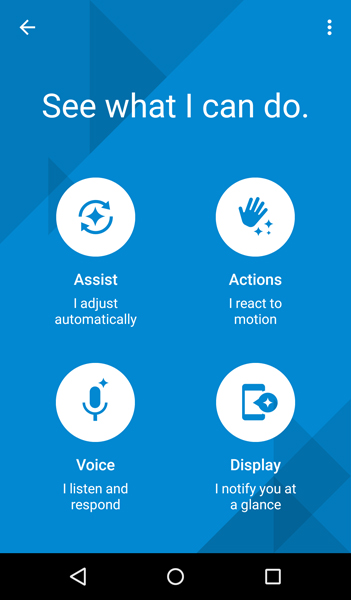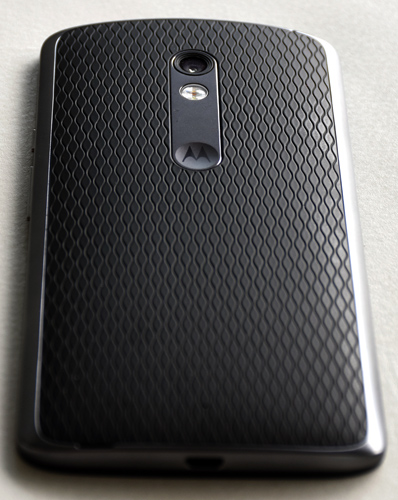
|
Display: 5.5-inch 1080p LCD display with 403 pixels per inch OS: Android 5.1.1 Lollipop Processor: 1.7GHz + 1GHz Snapdragon 615 octa-core processor Memory: 2GB RAM, 16GB (microSD card slot expandable up to 128GB) Camera: 21-megapixel rear camera, 5-megapixel front-facing Video: 1080p HD video recording at 30fps Battery: 3630mAh (non-removable) Connections: LTE, Wi-Fi (Wireless-AC), Bluetooth 4.0, NFC, A-GPS, Dual SIM Dimensions: 5.83 x 2.93 x 0.43 inches Weight: 169 grams Comes in Black and Teal |
Motorola is back and so is the Moto X, this time with the ‘Play’ moniker as a play on the phone’s longevity. The mid-range smartphone is Motorola’s newest flagship in Canada, packing in a huge battery into a frame that sports a larger display than last year’s model. A new camera has also been added to address the limitations of the prior Moto X handsets, pitting this device in a unique place that aims to capture the attention of consumers looking for a dependable smartphone that does everything.
Design
One of the design staples of the Moto X, going back to the original in 2013, is the curved back, and the X Play stays true to that. Only this time, the back panel has a rubberized and textured design, making it easier to grip and less likely to slip away. The added ruggedness also makes it water-resistant to splashes and a little rain, though it is most certainly not meant to be submerged underwater.
The screen has seen a bump up to 5.5-inches, albeit with an LCD panel instead of the AMOLED used in the previous two models. This means the overall contrast takes a dive, without the deeper blacks and saturated colours that OLED technology makes possible. It’s 1080p resolution—perfectly fine for a phone this size.
Under the hood is an octa-core processor, but this is not to the same level of performance as that found in, say, the Samsung Galaxy Note 5. The clock speed is lower here, and while that isn’t a detriment to regular performance, it does impact how fast and far you can go with this phone. The dual nano SIM slot is an interesting inclusion, and great for travelling. The slot for the second SIM can be used instead to put in a microSD card for expanding on the internal storage.
While the back panel comes off, the battery doesn’t. Not surprisingly, at 3630mAh, it takes up a lot of space, and adds a certain amount of weight to the device. But its longevity proves to be a major factor in the X Play’s usability.
The 21-megapixel rear camera is a major departure from previous models, and looks to improve on the lackluster performance of previous models.
Performance and software
 Motorola essentially maintained the same principles for the software. This is a version of Android that has been hardly touched, continuing the company’s practice of not messing with the operating system in any significant way.
Motorola essentially maintained the same principles for the software. This is a version of Android that has been hardly touched, continuing the company’s practice of not messing with the operating system in any significant way.
As before, the software is anchored by Motorola’s own useful add-ons. Moto Display pops up a very basic notification lockscreen in black and white, activating anytime the phone feels a vibration. Notifications are then actionable by sliding up from the app’s icon and sliding over to whichever function you want. I found this to be very convenient, save for the fact that tapping a button after sliding needs to be done quickly. For example, I wanted to skip back two tracks on a playlist I was listening to from SoundCloud. It took three tries to make it happen. The trick is to repeat the sequence. Slide up and tap skip back, and then follow up and do it again. Worked every time.
Moto Voice is the built-in voice assistant that has been part of the phone since the original Moto X in 2013. This includes Touchless Control for waking the phone with a voice command instead of touching it. That’s been expanded here to include more commands and integration with Google Now. I chose an awakening phrase (“Hey Moto X” or “Wake up, Moto X”), and then went about testing the other commanding phrases.
It’s possible to check voicemail, set reminders, set a calendar appointment and open the camera for a photo or selfie. Sending a text or WhatsApp is fairly seamless, with posting to Facebook reasonably well laid out. Some commands don’t always seem to work without deferring to Google Now, so whereas the cloud had no role in the previous models, it does a lot more here.
Assist, a previously standalone Moto app, is now baked into Moto Voice, so it can be set to automate certain functions when driving, sleeping or in a meeting.
Outside of that, overall performance is ideally suited to users who simply want a phone that does everything well, with some compromises thrown in. The X Play will handle most tasks with aplomb, but if you’re looking for something to do more hardcore gaming or intense video streaming and transcoding, the limits of the processor and RAM become evident.
Most users aren’t looking to do those things, however, so it’s more than serviceable for anyone looking to stick to the basics.
Camera
The quick draw to launch the camera has been tweaked to make it easier. Instead of a whole hand twisting motion, I only had to flick my wrist in both directions to feel the vibration confirming the camera was coming to life.
Beyond the theatrics, there was much room for improvement here, and the X Play delivers better overall performance and output, thanks, in large part, to the 21-megapixel image sensor and colour correcting temperature. The catch is that the superior results are based on how much light passes through the lens.

Daylight and bright light shots turn out really well, with good colour balance, saturation and composition. I found very minimal things to gripe about with those. Once the lights dimmed or the skies got darker, the sensor struggled to keep the grain away. The focusing is also automatic, which is fine, except that it doesn’t always lock onto a subject fast enough. I did end up getting annoyed at the lack of precision for such an important feature, though I imagine Motorola will release a software patch to fix that.
Personally, I also missed having full manual controls, having to rely more heavily on HDR to balance out certain shots. Without optical image stabilization and a wider aperture for the lens, it’s hard for the X Play’s image sensor to capture more light, so the results aren’t especially surprising to me. Still, more improvement in that respect would have made this camera a massive leap forward from its predecessor.
Battery life
 The 3630mAh battery is probably the shining star of this device. It’s huge by smartphone battery standards—considerably larger than even the latest flagships, for example. The lower-powered processor and restrained display mean battery drain is unlikely to be an issue.
The 3630mAh battery is probably the shining star of this device. It’s huge by smartphone battery standards—considerably larger than even the latest flagships, for example. The lower-powered processor and restrained display mean battery drain is unlikely to be an issue.
I was able to go over 36 hours and still have just under 20% left. That’s unheard of for most phones with regular daily usage. I came away impressed at how robust and consistent the battery turned out, never seeming to lose capacity quickly, no matter what task I was doing on the device.
Final Thoughts
If you’re not looking for a flashy smartphone, and battery life is of vital importance to you, the Moto X Play is a compelling choice. It doesn’t stand out for too many other reasons, otherwise. It maintains the dependable servitude of its predecessors, affirming that it will perform with the kind of consistency any smartphone user would want.
The camera, while much improved, still struggles in lower light situations, and the focusing needs to be fixed to facilitate quicker snaps. Moto Display and Moto Voice are nice features that add to the device’s usability, making the sum of its parts a dependable handset made for people who simply want something that works.
The Moto X Play is available now.



